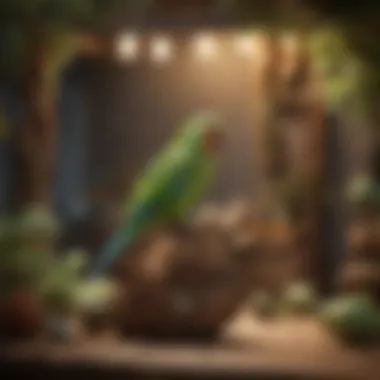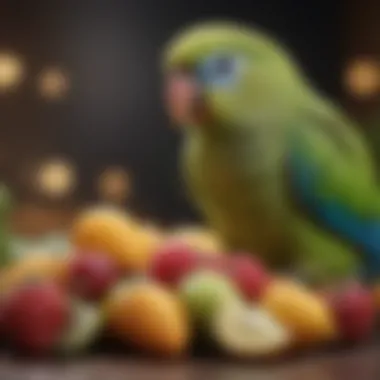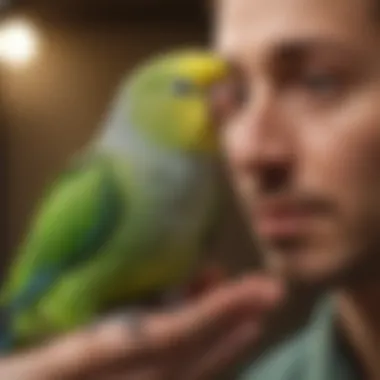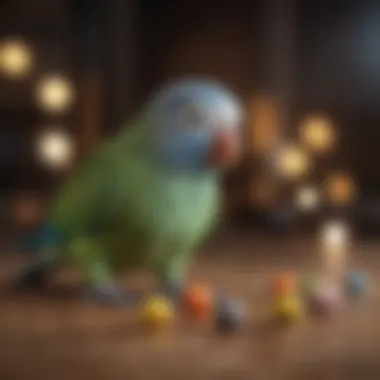Taking Care of Parakeets: A Complete Guide for Owners


Intro
Taking care of parakeets can be a rewarding yet challenging endeavor. These small birds are known for their vibrant colors and lively personalities. Not only do they bring joy, but they also require thoughtful attention to ensure their well-being. Owning a parakeet is not just about providing food and a cage; it is about understanding their basic needs and behaviors. This comprehensive guide aims to cover essential elements like environment setup, nutrition, health care, and behavior management.
Grooming Techniques
Grooming parakeets is essential for their health and happiness. Proper grooming helps maintain their feathers and skin, ensuring that they remain vibrant and free from issues. A regular grooming routine helps in building trust between the owner and the bird.
Basic Grooming Tools
Having the right tools can make grooming your parakeet easier and more effective. The following tools are generally necessary:
- Bird-safe scissors: Often used for trimming feathers if they become overly long.
- Nail clippers: Specially designed for birds to prevent injury.
- Soft brush: Used to remove loose feathers and dust from their plumage.
- Grooming mitts: These can help remove excess dander and dirt from their body.
Step-by-Step Grooming Guides
- Feather Inspection: Start by checking your bird’s feathers for any debris or tangles.
- Brushing: Use a soft brush to gently brush the feathers, moving from the head toward the tail.
- Nail Trimming: Carefully clip the nails while avoiding the quick, which can cause bleeding.
- Bathing: Encourage your parakeet to take a bath regularly. This can be done with a shallow dish of water or a gentle spray.
Breed-Specific Grooming Needs
Some parakeet breeds have unique grooming requirements. For example:
- Budgerigar: Requires feather clipping occasionally to prevent flying injuries.
- English Budgie: Has denser feathering, making them prone to oil buildup, thus needing more frequent baths.
Health and Wellness
Maintaining your parakeet's health is crucial for a long, happy life. Be aware of the signs of good health and common illnesses.
Nutrition and Diet Tips
A balanced diet is important. Parakeets should primarily eat high-quality pellets. Supplement their diet with fresh fruits, vegetables, and occasional seeds. Aim to provide:
- Fresh leafy greens like kale, spinach, or romaine.
- Fruits such as apples, pears, and berries.
- A small quantity of seeds to reward them.
Common Health Issues and Solutions
Parakeets can suffer from various health problems. Being aware can help in addressing them early. Common issues include:
- Feather Plucking: Can arise from stress; maintain a stable environment.
- Respiratory Issues: Caused by dust or mold; ensure good ventilation.
Importance of Regular Check-Ups
Routine veterinary visits are essential. A vet specializing in avian care can provide preventive health checks and vaccinations. This can help catch potential health issues before they escalate.
Training and Behavior
Training parakeets is key to developing a harmonious relationship. Understanding behavior assists as well.
Basic Training Commands
Start with simple commands. For example:
- Step Up: A common command to encourage your bird to perch on your finger.
- Come: Encourages your parakeet to return to you.
Understanding Common Behavioral Issues
Parakeets can display various behaviors. Remember:
- Screaming: Could indicate boredom or the need for attention.
- Aggression: May signal fear or territoriality.
Techniques for Effective Training
- Positive Reinforcement: Always reward desired behaviors with treats or praise.
- Consistency: Use the same commands to avoid confusion.
Product Reviews
Research and reviews can aid in selecting the right products for your parakeet.
Comparison of Grooming Tools
When it comes to grooming tools, read reviews of brands like the Kaytee Bird Scissors and Zolux Nail Clippers. They offer safety and ease of use.
Best Pet Products for Health
Look into Harrison's Bird Foods for nutritional pellets and Avitech for vitamin supplements. They support overall health.
Review of Training Aids


Several devices can assist with training. Consider the PetFusion Bird Training Kit for effective learning.
Community Insights
Real experiences can enhance understanding.
User-Submitted Tips and Tricks
Many parakeet owners share practical advice online. Platforms like Reddit and Facebook have valuable user-generated content.
Real-Life Grooming Experiences
Reading about others’ grooming experiences can help you form a better routine. Join online forums for advice from seasoned owners.
Expert Guest Contributions
Inviting avian experts to share tips adds depth. Their insights can guide new and experienced parakeet owners alike.
Education and prevention lead to a long-lasting, healthy bond with your parakeet.
Preface to Parakeets
Parakeets are small, lively birds that bring charm and vibrancy to homes. Understanding parakeets is crucial for anyone considering adding them as pets. This section outlines various aspects that make parakeets unique, including their behavior, social needs, and distinctive features.
Parakeets are known for their bright plumage and playful personalities. They require attention and care, which is why it is essential to know their specific requirements. This knowledge not only ensures their well-being but also helps build a strong bond between the pet and the owner.
Some important considerations about parakeets include:
- Social Nature: Parakeets thrive in social environments. They are known for forming strong bonds, whether with their owners or fellow birds. This aspect is vital for those planning to keep a parakeet as a single pet; companionship is often recommended.
- Vocalization: Unlike some other pets, parakeets are vocal birds. They communicate through chirps and whistles, making them engaging companions. Understanding their communication can lead to better interaction and a more enriched life for the bird.
- Size and Lifespan: Typically small in size, parakeets have a lifespan of around 5 to 15 years. Knowing this allows prospective owners to commit long-term to their care.
Considering these elements will provide a strong foundation for new and prospective parakeet owners. This section will guide readers in appreciating the nuances of parakeet care, fostering care practices that enhance the overall experience of living with these delightful creatures.
Choosing the Right Parakeet
Choosing the right parakeet is a crucial first step in creating a rewarding companionship. Parakeets, or budgerigars, are known for their vibrant colors, engaging personalities, and ability to mimic sounds. However, selecting the ideal parakeet goes beyond just looks. It involves understanding the specific needs of different species, their behaviors, and how they fit into your lifestyle. This section aims to illuminate the different facets of choosing a parakeet, focusing on species diversity and considerations before adoption.
Common Parakeet Species
When it comes to parakeets, several species stand out. The most common is the Budgerigar, often simply called a
Setting Up the Ideal Habitat
Creating a proper habitat for your parakeet is crucial for their overall well-being. The environment in which they live directly influences their health, behavior, and happiness. An inadequate habitat may lead to stress, behavioral issues, and even health problems. Thus, understanding the key elements of an ideal cage setup is essential. This section breaks down the various components required to establish a nurturing and stimulating space for your feathered friend.
Cage Size and Type
Choosing the right cage involves more than just aesthetics. Parakeets require enough space to move freely, spread their wings, and engage in natural behaviors. The size of the cage should ideally be at least 24 inches long, 18 inches wide, and 18 inches tall for a single parakeet, but bigger is always better if you can accommodate it.
The type of cage also matters. Look for models made of non-toxic materials, with vertical bars to provide climbing opportunities. Some options include:
- Wire Cages: These are common and provide ventilation. Ensure the bars are spaced close enough to prevent escape.
- Acrylic Terrariums: These can limit dust and mess but may not provide ample ventilation if not designed correctly.
- Playtop Cages: These have additional play areas on top which offer enrichment.
While selecting a cage, focus on quality and safety. Avoid cages made with harmful coatings or small openings. Remember, a good cage provides a strong foundation for a happy and healthy parakeet.
Essential Cage Accessories
Accessories in the cage are just as important as the cage itself. They help simulate a more natural environment and keep your parakeet stimulated. Essential accessories include:
- Perches: Varied perch sizes and materials promote healthy feet. Incorporating natural wood perches alongside concrete or rope ones helps prevent boredom.
- Food and Water Dishes: Use sturdy, easy-to-clean dishes that are secure to avoid spills. A clear supply of fresh water is vital.
- Toys: Toys are necessary for mental stimulation. Choose toys that encourage chewing, climbing, and problem-solving. Rotate toys regularly to maintain interest.
- Hiding Spaces: Add small shelters where parakeets can retreat when feeling stressed or tired.
Including a variety of these accessories will create a dynamic living space that encourages exploration and activity.
Location of the Cage in the Home
The ideal location for your parakeet's cage plays a crucial role in its quality of life. Select a spot that balances safety, interaction, and comfort. Consider these factors when choosing a location:
- Natural Light: Place the cage where it can receive natural light, but avoid direct sunlight that can cause overheating.
- Social Interaction: Position the cage in an area where your parakeet can engage with family members. They thrive on social interaction, so keeping them near common living spaces is beneficial.
- Avoiding Risks: Keep the cage away from hazards such as drafts, kitchen smoke, or noisy environments that can cause anxiety.
In summary, a well-envisioned habitat requires the right cage size and type, properly selected accessories, and a thoughtful placement within your home. Your parakeet deserves an enriched environment to thrive, and attention to these details is a significant step toward achieving that.
Nutrition and Diet for Parakeets
Proper nutrition is vital for the health and longevity of parakeets. These small birds have specific dietary needs that must be met to ensure their well-being. A balanced diet not only supports their physical health but greatly influences their mood, behavior, and activity level. Well-fed parakeets exhibit more vibrant colors and are generally more lively. Understanding their unique nutritional requirements is essential for any bird owner.
Understanding Nutritional Needs
Parakeets require a well-rounded diet consisting of various nutrients. A mix of seeds, pellets, fruits, and vegetables is essential. Parakeets are naturally seed eaters, but they benefit significantly from additional sources of vitamins and minerals found in pellets and fresh produce.


Key Nutritional Elements:
- Proteins: Vital for growth, maintenance, and overall health. Found in seeds and some pellets.
- Fats: Provide energy. Should be taken in moderation to avoid obesity.
- Carbohydrates: Offer quick energy, primarily sourced from fruits and vegetables.
- Vitamins and Minerals: Essential for bodily functions. A variety of foods helps ensure they receive enough.
The balancing of these nutrients can help avoid deficiencies. It's important to closely monitor how much and what your parakeet eats.
Types of Food to Offer
Providing a variety of food types keeps your parakeet interested and healthy. Here are common categories:
- Seeds: A traditional diet staple, seeds can be rich and flavorful. However, relying solely on seeds can lead to nutritional deficits. Seed mixes that are meant for parakeets should include canary seeds, millet, and oats.
- Pellets: Commercially prepared pellets are designed to provide complete nutrition. Many owners find this to be a better option than seed-only diets. Pellets should make up the majority of the diet.
- Fresh Fruits and Vegetables: Fresh produce can be introduced slowly. Some good options include spinach, carrots, apples, and berries. They offer hydration and essential nutrients.
- Nuts and Treats: While nuts can be a good snack, they are high in fat and should be given sparingly. Treats should never constitute a large part of the diet.
Important Points to Note
- Avoid avocados, chocolate, and caffeine as these are toxic.
- Ensure fresh food is washed and free from pesticides.
Fresh Foods and Treats
Fresh foods are highly beneficial for parakeets. They add variety and promote healthy eating habits. Fresh fruits and vegetables can be given daily, but it's key to observe which ones your parakeet prefers. Gradual introduction of new items can prevent digestive upset.
Suggested Fresh Foods:
- Fruits: Apples (without seeds), bananas, grapes, and melons.
- Vegetables: Carrots, broccoli, peas, and cucumbers.
Treats:
Treats can be a useful tool for training or rewarding your parakeet. Small bits of fruit or commercially prepared treats can be used, but should be limited to avoid dietary imbalance.
A well-structured diet will lead to vibrant, healthy parakeets. Being aware of what to feed them will make a substantial difference in their lives.
Health Care and Maintenance
Taking care of parakeets involves more than just providing food and water. Health care and maintenance are critical for ensuring their longevity and happiness. Regular attention to health can prevent serious issues from developing and allows owners to spot potential problems early.
Understanding the specific health needs of parakeets can also enhance the bond between the pet and its owner. Engaging in health checks fosters a sense of trust and security, making parakeets more comfortable during interactions.
Regular Health Checks
Routine health checks are essential to assess the overall condition of your parakeet. Owners should observe their birds daily for changes in behavior, appetite, and appearance. Common areas to focus on during health checks include:
- Feathers: Look for any signs of damage or excessive molting.
- Eyes: They should be bright and clear, without any discharge.
- Beak and Feet: Make sure there are no abnormalities or signs of injury.
- Weight: Keep track of your parakeet's weight to notice any sudden changes.
Performing these checks regularly helps in identifying issues early, making it easier to address them before they escalate.
Identifying Common Health Issues
Parakeets may face several health issues throughout their lives. Some common conditions include:
- Psittacosis: This is a bacterial infection that can affect birds and is zoonotic, meaning it can affect humans as well. Symptoms include lethargy and nasal discharge.
- Respiratory Problems: Look for signs such as wheezing or difficulty breathing, which can be due to poor air quality or infections.
- Feather Plucking: This behavior can be caused by stress or medical issues and needs prompt attention.
- Obesity: Parakeets that overeat can suffer from health issues similar to obesity in humans, including fatty liver disease.
Being proactive in recognizing these symptoms can lead to quicker treatment and better outcomes for your parakeet.
Veterinary Care Considerations
Regular visits to a qualified avian veterinarian are crucial for your parakeet's health. These professionals can provide preventive care such as:
- Annual Checkups: A routine examination can reveal underlying health issues.
- Required Vaccinations: Stay informed about necessary vaccinations for your bird.
- Nutritional Guidance: Your vet can recommend adjustments to your parakeet's diet based on its health status.
- Any Necessary Treatments: If your parakeet shows signs of illness, your vet can prescribe appropriate medications.
Maintaining open communication with your veterinarian will help you provide the best care possible for your companion.
Overall, diligent health care combined with regular maintenance routines will not only help prevent disease but also contribute to a fulfilling life for your parakeet.
Socialization and Interaction
Socialization and interaction play a vital role in the overall well-being of parakeets. These birds are inherently social creatures. Their natural instincts prompt them to engage with their surroundings and fellow birds. For pet owners, understanding these instincts ensures that parakeets receive both mental and physical stimulation. When kept alone, parakeets might exhibit signs of distress or boredom. Thus, socialization with humans and other pets becomes crucial to their happiness.
Understanding Parakeet Behavior
Understanding parakeet behavior is essential for any owner who wants to foster a healthy environment. Parakeets communicate through various vocalizations and body language. Owners should pay attention to these cues to understand their pet’s needs. For instance, a parakeet that is chirping enthusiastically may be expressing contentment, while an agitated bird might puff up its feathers or assume a defensive posture.
Here are some key behaviors to recognize:
- Chirping: Indicates happiness or the desire for interaction.
- Wing Flapping: Can signify excitement or a need for exercise.
- Preening: Essential for maintaining feathers and indicating comfort.
- Hiding or Crouching: May suggest fear or illness.
Being observant of these behaviors helps owners respond appropriately, ensuring that their parakeets feel secure and connected.
Importance of Social Interaction


Social interaction is not a luxury but a necessity for parakeets. Without sufficient interaction, they can suffer from loneliness and develop behavioral issues such as excessive screeching or feather plucking. Here are several benefits of encouraging social interactions:
- Emotional Health: Socializing reduces stress and anxiety in parakeets, leading to a more relaxed and confident demeanor.
- Cognitive Development: Engaging with humans and even toys fosters mental stimulation, preventing boredom and the associated negative behaviors.
- Bonding: Regular interaction strengthens the bond between the owner and pet. This emotional connection can lead to a more affectionate and friendly bird.
It is advisable to set aside regular times for interaction, whether it be through talking, training, or simply allowing the bird out of its cage to explore a safe area. The more engaged the owner is, the more fulfilled the parakeet will be.
Regular social interaction is key to a happy and healthy parakeet.
Enrichment Activities for Parakeets
Enrichment activities play a crucial role in ensuring the overall well-being of parakeets. These activities not only help prevent boredom but also stimulate their minds and bodies. Parakeets are intelligent and social creatures, which means that they require engagement to thrive. Without adequate enrichment, these birds may develop behavioral problems or health issues. Thus, providing various forms of stimulation can support their physical and mental health.
By incorporating enrichment activities into your parakeet's daily routine, you can enhance their quality of life. Enrichment gives them opportunities to explore, learn, and interact, thus mimicking their natural behaviors in the wild. These activities promote physical exercise and mental agility, contributing to a balanced lifestyle.
Toys and Playtime
Toys are essential for keeping your parakeet entertained. Birds can become easily bored if they do not have fun things to play with. This boredom can lead to negative behaviors, like feather plucking or excessive screeching. Not only do toys provide entertainment, they also encourage physical activity, which is vital for your bird's health.
When selecting toys, consider the following:
- Safety: Ensure toys are made from non-toxic materials without small parts that could be swallowed.
- Variety: Offer a range of textures and shapes. Common toy types include chew toys, swings, and puzzle toys that challenge their intellect.
- Rotation: Change toys periodically to maintain interest. Birds enjoy novelty, and rotating toys can keep them engaged longer.
Setting aside dedicated playtime is equally important. This time allows for free exploration and exercise outside of the cage. Employing a bird-safe area in your home for this purpose ensures they can stretch their wings.
Training Techniques
Training your parakeet is another excellent form of enrichment. Not only does training foster a closer bond between you and your bird, it also provides mental stimulation. Parakeets can learn tricks and commands that reinforce positive behaviors.
When engaging in training, follow these approaches:
- Positive Reinforcement: Use treats or praise to reward desired behaviors. This technique encourages your parakeet to repeat those behaviors.
- Short Sessions: Keep training sessions brief but frequent. Parakeets have short attention spans, so short bursts of focus will be more effective.
- Consistency: Be consistent with commands and rewards. This helps your parakeet learn faster by helping them understand what behaviors are desired.
- Patience: Every bird learns at their own pace. Patience is key in the training process.
Engaging in enrichment activities is vital for your parakeet's happiness and health. Without adequate stimulation, they can become bored, leading to detrimental behaviors.
Common Misconceptions About Parakeets
Understanding common misconceptions about parakeets is crucial for their proper care and well-being. Many potential owners or new parakeet keepers operate under false beliefs that can negatively impact these birds' lives. Clarifying these myths allows for informed decisions, promotes better animal welfare, and fosters a positive human-animal relationship.
Myths vs.
Reality
1.
Parakeets are Easy Pets Many might think that parakeets are easy pets requiring little attention or care. While they are relatively low-maintenance compared to larger birds, they still need routine care, social interaction, and mental stimulation. Neglecting these needs can lead to behavioral issues.
2.
Parakeets Can Live Independently Another common belief is that parakeets can thrive without interaction from their owners. Parakeets are social animals requiring bonding not just with one another but also with humans. A lack of social interaction can lead to loneliness and stress, which impacts their health.
3.
All Parakeets are Quiet The impression that all parakeets are quiet creatures is misleading. Some breeds and individuals can be quite vocal, especially during the day. These vocalizations can be a form of communication and should not be regarded as a nuisance.
4.
Parakeets Only Eat Seed Mixes It's a misconception that a seed-based diet is sufficient for parakeets. A varied diet, including pellets, fruits, and vegetables, is vital for their health. Seeds alone lack essential nutrients required by these birds.
5.
Parakeets Do Not Need Bathtime Another myth is that parakeets do not need to bathe. In fact, regular bathing is important for their feather maintenance and overall hygiene. Providing a shallow dish of water or misting them can be beneficial.
“Providing accurate information helps parakeet owners foster healthy environments for their birds.”
6.
Male Parakeets are Better Pets than Females There's a belief that male parakeets are better companions than females, which is not universally true. Each bird has a unique personality, and both genders can make excellent pets depending on the environment and care given.
7.
Parakeets Don’t Require Training It's often thought that parakeets do not require any form of training. However, training is essential for their well-being and can provide mental stimulation. Simple commands and tricks improve their quality of life and strengthen the bond between pet and owner.
In summary, debunking these misconceptions assures that parakeets are given the love, care, and environment they truly need. Being aware of these myths allows for better practices in parakeet care. Keeping informed can enhance the experience of owning these vibrant companions.
Closure
In the realm of parakeet care, the conclusion serves as a vital summarization and reflection on all the preceding themes discussed. By this point, readers have gained insights into various aspects of parakeet ownership, from habitat setup to nutrition and health care. Each detail contributes to a holistic understanding of how to provide a nurturing environment for these enchanting birds.
The core benefit of this comprehensive guide lies in its ability to synergize multiple elements crucial for a parakeet's well-being. For instance, a well-structured habitat is not merely about choosing the right cage size; it also involves understanding social dynamics and the enrichment activities essential for mental stimulation.
Moreover, this article has emphasized the significance of recognizing a parakeet’s dietary needs. Proper nutrition not only helps maintain physical health but can also significantly influence behavior and activity levels. When parakeet owners are equipped with knowledge about fresh foods, seeds, and pellets, they contribute positively to their pet's quality of life.
Health care is another fundamental component discussed. Owners must learn not only to identify common health issues but also to anticipate them through regular check-ups. Early detection of health problems can save lives and ensure a long, healthy life for parakeets. The integration of veterinary care into the daily routine establishes a baseline of health that every parakeet deserves.
In summary, this comprehensive guide has provided essential insights into the complex world of parakeet care. By applying the knowledge acquired from each section, enthusiasts can enhance their pets' lives and create a nurturing environment where parakeets thrive. Through diligence, compassion, and informed care, parakeet owners can ensure that their companions enjoy a fulfilling and vibrant existence.







